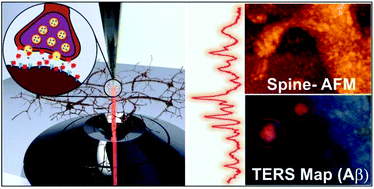Tip-enhanced Raman spectroscopy of amyloid β at neuronal spines†
Abstract
The early stages of Alzheimer's disease pathogenesis are thought to occur at the synapse level, since synapse loss can be directly correlated with memory dysfunction. Considerable evidence has suggested that amyloid beta (Aβ), a secreted proteolytic derivative of amyloid precursor protein, appears to be a critical factor in the early ‘synaptic failure’ that is observed in Alzheimer's disease pathogenesis. The identification of Aβ at neuronal spines with high spatial resolution and high surface specificity would facilitate unraveling the intricate effect of Aβ on synapse loss and its effect on neighboring neuronal connections. Here, tip-enhanced Raman spectroscopy was used to map the presence of Aβ aggregations in the vicinity of the spines exposed to Aβ preformed in vitro. Exposure to Aβ was of 1 and 6 hours. The intensity variation of selected vibrational modes of Aβ was mapped by TERS for different exposure times to Aβ. Of interest, we discuss the distinct contributions of the amide modes from Aβ that are enhanced by the TERS process and in particular the suppression of the amide I mode in the context of recently reported observations in the literature.



 Please wait while we load your content...
Please wait while we load your content...